![]()
![]()
![]()
Use LEFT and RIGHT arrow keys to navigate between flashcards;
Use UP and DOWN arrow keys to flip the card;
H to show hint;
A reads text to speech;
96 Cards in this Set
- Front
- Back
- 3rd side (hint)
|
Which bones form the pelvic girdle? |
Sacrum Coccyx 2 innomimate bones (os coxae) |
|
|
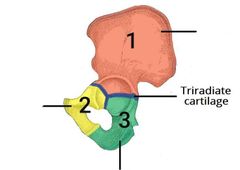
|
1. Ilium 2. Pubis 3. Ischium |
|
|
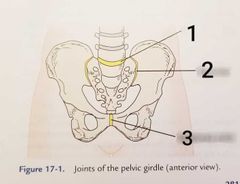
|
1. Lumbosacral 2. Sacroiliac 3. Symphysis pubis |
|
|
|
The pelvic girdle allows motion in ___ planes. |
3 |
|
|

|
1. False pelvis (greater or major) 2. True pelvis (lesser or minor) |
|
|
|
How is the sacroiliac joint classified and what is its function? |
Nonaxial, plane To transfer weight from UB thru spine to hip bones. |
|
|

|
1. Nutation (sacral flexion) 2. Counternutation (sacral extension) |
|
|
|
____ occurs with trunk flexion or hip extension while ____ occurs with trunk extension or hip flexion. |
Nutation, counternutation |
|
|

|
Anterior sacroiliac ligament |
|
|
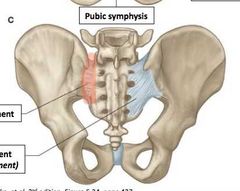
|
Interosseous sacroiliac ligament |
|
|
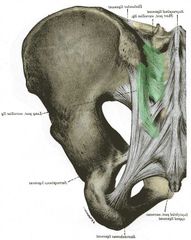
|
Posterior sacroiliac ligament Long portion prevents downward movement of sacrum. Short portion prevents forward movement of sacrum. |
|
|
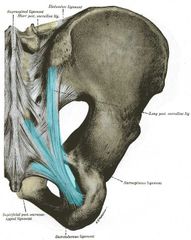
|
Sacrotuberous ligament Strong, triangular ligament that attaches on the ischial tuberosity and prevents forward rotation of sacrum. |
|
|
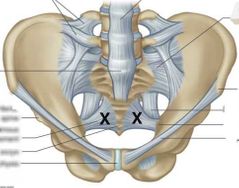
|
Sacrospinous ligament Runs from lower, lateral sacrum and coccyx to spine of ischium. |
|
|
|
What type of disk is between the two pubic bones? |
Fibrocartilage |
|
|
|
What type of joint is the pubic symphysis? |
Amphiarthrodial |
|
|
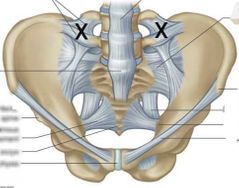
|
Iliolumbar ligament Limits rotation between L5/S1 and prevents anterior movement of L5 on S1. |
|
|
|
What is indirectly responsible for creating the spinal curves? |
Lumbosacral angle |
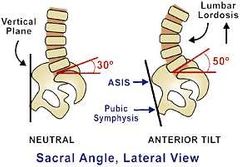
|
|
|
What is the optimal lumbosacral angle? |
30 (degrees) |
|
|
|
What might cause a person to stand with the pelvis tilted anteriorly? |
Hip flexion contracture |
|
|
|
What might cause a person to stand with the pelvis tilted posteriorly? |
Tight hamstrings |
|
|
|
What is the point of reference for lateral tilt of the pelvis? |
Unsupported or NWB side |
|
|
|
What other joint motions are affected by pelvic tilt? |
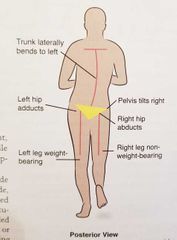
|
|
|
|
Pelvic anterior/posterior tilt occur in which plane? What about lateral tilt? |
A/P tilt: sagittal Lateral tilt: frontal plane |
|
|
|
What is an important landmark in pelvic movement? |
ASIS (anterior superior iliac spine) |
|
|
|
Right pelvic forward rotation would cause what movement at the left hip (WB side)? |
Medial rotation |
|
|
|
Right pelvic backward rotation would cause what movement at the left hip (WB side)? |
Lateral rotation |
|
|
|
Which muscles form a force couple to anteriorly tilt the pelvis? |
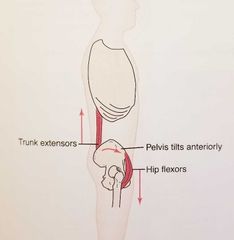
Erector spinae pull up. Iliopsoas, sartorius pull down. |
|
|
|
Which muscles form a force couple to posteriorly tilt the pelvis? |

Gluteus maximus, hamstrings pull down. Rectus abdominis pulls up. |
|
|
|
If a person stands with a habitual anterior tilt, which muscles will shorten? Which ones lengthen and become weak? |
Shorten: trunk extensors, hip flexors Lengthen: trunk flexors, hip extensors |
|
|
|
What are some characteristics of the female pelvis? |
- more oval inlet - shorter cavity - shorter, less curved sacrum - iliac walls not as vertical - ischial tuberosities farther apart - rounded pelvic arch |
|
|
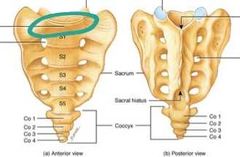
|
Sacral promontory |
|
|
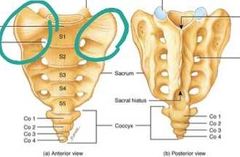
|
Ala |
|
|
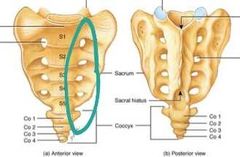
|
Foramina |
|
|
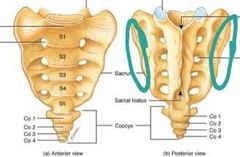
|
Auricular surface |
|
|
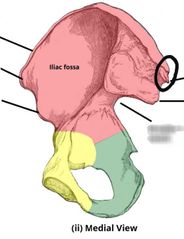
|
PSIS (posterior superior iliac spine) |
|
|
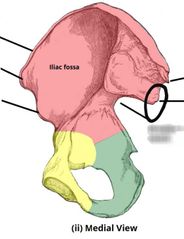
|
PIIS (posterior inferior iliac spine) |
|
|
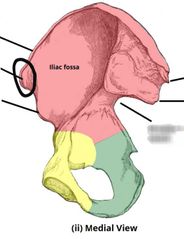
|
ASIS (anterior superior iliac spine) |
|
|

|
AIIS (anterior inferior iliac spine) |
|
|
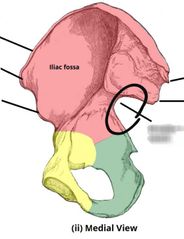
|
Greater sciatic notch |
|
|
|
What forms the greater sciatic foramen? |
Greater sciatic notch (ilium, ischium) Sacrotuberous ligament Sacrospinous ligament |
|
|
|
What is a common site for fractures of the hip bone? |
Superior/inferior ramus of pubis |
|
|
|
Which bones form the acetabulum? |
Ilium, ischium, pubis |
|
|
|
What are the reference points for anterior/posterior tilt of pelvis? |
ASIS, pubic symphysis |
|
|
|
What are normal ranges and end feels for these hip motions? Flexion/extension Abduction/adduction IR/ER |
Flexion 0-120 soft or firm Extension 0-30 firm Abduction 0-45 firm Adduction 0-30 firm IR 0-45 firm ER 0-45 firm |
|
|
|
The hip is a ____ joint. |
Triaxial |
|
|
|
What is open-packed position for the hip? |
30* of flexion and abduction, slight ER |
|
|
|
What is closed packed position for the hip? |
Full extension, IR |
|
|
|
What is the capsular pattern of the hip? |
Flexion > abduction > IR |
|
|
|
When doing joint mobs a posterior glide of the head of the femur will stretch the posterior capsule and increase which movements? |
Flexion, IR (When accessory motions of the femoral head are limited, a mobilizing force that moves the head of the femur into the direction of restriction can help restore motion.) |
|
|
|
Small projection proximal to the medical epicondyle of femur |
Adductor tubercle |
|
|
|
Prominent longitudinal ridge running down the middle third of the posterior shaft of the femur |
Linea aspera |
|
|
|
Which ligament reinforces the hip joint capsule anteriorly and what motion does it limit? |
Iliofemoral ligament, limits hyperextension |
|
|
|
What are some other names for the iliofemoral ligament? |
Y ligament, ligament of Bigelow |
|
|
|
Which ligament reinforces the hip joint capsule medially/inferiorly and what motion does it limit? |
Pubofemoral ligament, limits hyperextension and abduction |
|
|
|
Which ligament reinforces the hip joint capsule posteriorly and what motion does it limit? |
Ischiofemoral ligament, limits hyperextension and IR |
|
|
|
Which ligament allows a person to stand in the upright position without using any muscles and what is this called? |
Iliofemoral ligament, "hanging on the Y ligament " (This is the basis for the standing posture of someone with paralysis due to spinal cord injury.) |
|
|
|
What increases the depth of the hip socket? |
Acetabular labrum |
|
|
|
When the external iliac artery and vein pass under the ____ ligament, their names change to the ____ artery and vein. |
Inguinal, femoral |
|
|
|
What passes through the adductor hiatus? |
Femoral artery and vein (Here their names change to the popliteal artery and vein.) |
|
|
|
The hip has a group of one-joint muscles that provide ____ and a group of two-joint muscles that provide ____. |
Control, ROM |
|
|
|
Which muscle in the quadriceps group crosses the hip joint? |
Rectus femoris |
|
|
|
What is the longest muscle in the body? |
Sartorius |
|
|
|
Which muscle is most efficient when performing a combination of hip ✔/abd/ER? |
Sartorius - known as the tailor's muscle |
|
|
|
Which tendon is palpated when checking the fit of an AK prosthesis? |
Tendon of adductor longus |
|
|
|
Name the adductor muscles from superficial to deep. |
Adductor longus Adductor brevis Adductor magnus |
|
|
|
Which is the only hip adductor that crosses two joints? |
Gracilis |
|
|
|
List the six deep lateral rotators from superior to inferior. |
Piriformis Gemellus superior Obturator internus Gemellus inferior Obturator externus Quadratus femoris |
Piece goods often go on quilts. |
|
|
Tightness of which muscle may compress the sciatic nerve? |
Piriformis |
|
|
|
Which muscles originate on the ischial tuberosity? |
Biceps femoris Semitendinosus Semimembranosus |
|
|
|
Which muscles insert on the anteromedial surface of the tibia? |
Sartorius Gracilis Semitendinosus This is the pes anserine (goose foot) muscle group. |
|
|
|
The short head of the biceps femoris does what action? |
Knee flexion |
|
|
|
When standing on one leg, which muscles contract on the supported side to keep the pelvis fairly level? |
Gluteus medius and minimus |
|
|
|
Which muscle is strongest when performing a combination of hip flexion/abduction? |
Tensor fascia lata |
|
|
|
What hip pathology occurs in children during the growth spurt years? |
Slipped capital femoral epiphysis |
|
|
|
Angle between the shaft and neck of the femur in the frontal plane |
Angle of inclination |
|
|
|
Angle between the shaft and neck of the femur in the transverse plane |
Angle of torsion |
|
|
|
Angle of inclination greater than 125* |
Coxa valga - This tends to make the limb longer, placing it in an adducted position when WB. |
|
|
|
Angle of inclination less than 125* |
Coxa vara - This tends to make the limb shorter, dropping the pelvis on that side when WB. |
|
|
|
What is an increase in the angle of torsion called and how does it cause a person to walk? |
Anteversion, person walks toed in |
|
|
|
What is a decrease in the angle of torsion called and how does it cause a person to walk? Hint: Uncle Hank |
Retroversion, person walks toed out, the "duck walk" |
|
|
|
Overuse injury that causes lateral knee pain; seen in runners and bicyclists |
Iliotibial band syndrome |
|
|
|
One of the most common muscle problems; caused by overload or trying to move the muscle too quickly |
Hamstring strain (pulled hamstring) |
|
|
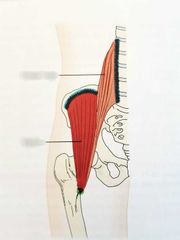
|
Iliopsoas - psoas major and iliacus |
|
|
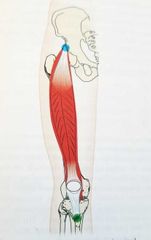
|
Rectus femoris |
|
|
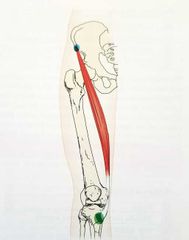
|
Sartorius |
|
|
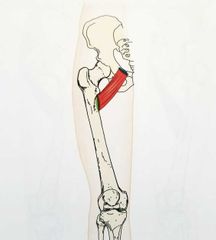
|
Pectineus |
|
|
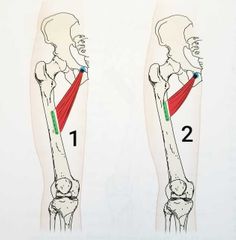
|
1. Adductor longus 2. Adductor brevis |
|
|
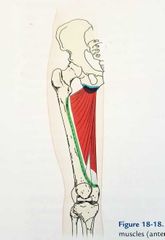
|
Adductor magnus |
|
|
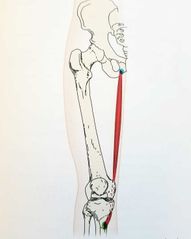
|
Gracilis |
|
|
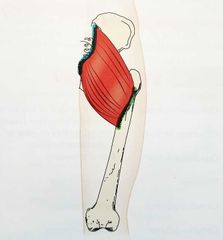
|
Gluteus maximus |
|
|
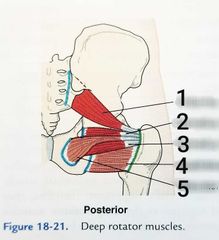
|
1. Piriformis 2. Gemellus superior 3. Gemellus inferior 4. Quadratus femoris 5. Obturator internus |
|
|
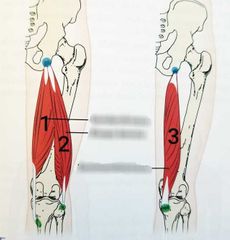
|
1. Semitendinosus 2. Biceps femoris, long head 3. Semimembranosus |
|
|
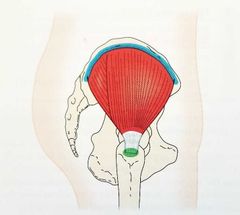
|
Gluteus medius |
|
|
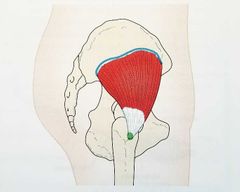
|
Gluteus minimus |
|
|
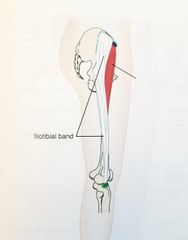
|
Tensor fascia lata |
|
|
|
Bony landmark of the femur which runs from below the lesser trochanter diagonally toward the linea aspera |
Pectineal line |
|

